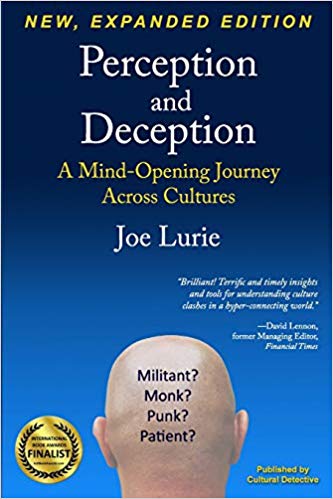Craig Storti (Morocco) Interviews Joe Lurie (Kenya) in June SIETAR Newsletter
CRAIG STORTI INTERVIEWS JOE LURIE ABOUT HIS BOOK “PERCEPTION AND DECEPTION: A MIND-OPENING JOURNEY ACROSS CULTURES”
Society for Intercultural Education, Training and Research Newsletter
June 10, 2019 |
 Interview with Joe Lurie, Executive Director Emeritus, UC Berkeley International House
Interview with Joe Lurie, Executive Director Emeritus, UC Berkeley International House
Why did you write this book?
With YouTubes, tweets and fake news crossing cultures instantly and without context and with a surge of migrants encountering new hosts from different countries for the first time and without preparation, I sensed a growing collision of cultures. The alarming increase in intercultural misperceptions and miscommunications makes it more essential than ever to understand the actual meanings and intentions behind words and actions which may seem abnormal, provocative, even threatening. And so I wrote the book to heighten awareness of these misunderstandings and to provide tools for understanding culture clashes in the news of the day, in business, technology, diplomacy, language, religion, generational divides and migration. In a recent talk I illustrated a key theme in the book by showing how and why a simple bus seat in Norway was widely perceived as a burqua! https://youtu.be/EG_pv0gTNvY
What is the most important thing you want readers to take away from this book?
An awareness of how the limitations of our experiences, no matter how extensive, within and across cultures, can blind us to and distort the underlying reality and meaning of behaviors, values, and beliefs never before encountered. As a 4th century Chinese poem ponders: “How shall I explain the sea to a frog that has never left its pond?” Or, as noted in this video clip, how all of us are in a sense locked in a perceptual cage of finite experiences. https://youtu.be/aIVsmbhi3RI
Name one or two books in our field that influenced you the most, that you think all interculturalists should be familiar with? Why?
The Geography of Thought-How Asians and Westerners Think Differently and Why by Richard E, Nisbett. A fascinating exploration of common East/West cultural contrasts that explains how differing world views and behaviors are often rooted in contrasting social structures, philosophies, and educational systems that date back to ancient Greece and China. It’s a thought-provoking challenge to the widespread assumption among cognitive scientists that thinking across cultures is fundamentally the same.
The scholarly article “Cross-Cultural Training Across The Individualism-Collectivism Divide” by Triandis, Brislin and Hui. I use this superb tool in my classes and training sessions, not only to help explain these contrasts but more importantly to provide powerful guidance for individualists on how to understand and interact with collectivists, and vice-versa.
What is one of the most significant, most memorable cross-cultural experiences you have had?
As a Peace Corps Volunteer in Kenya and as one who is heterosexual, I was shocked and deeply disturbed when men held my hand for extended periods of time while strolling or engaged in casual conversation .It took awhile to understand that this had nothing to do with homosexuality, that throughout Africa, parts of the Middle East and Asia this is a common male heterosexual behavior. This experience was my awakening to how culture can shape the meaning of behavior, and it was the origin and inspiration for a lifetime of intercultural discoveries.
If you could pass on only one insight/one lesson learned to others about crossing cultures, what would you say?
When encountering someone from another culture whose behavior seems confusing, bizarre or offensive, think of the West African Dogon proverb, “The Stranger Sees only What He Knows,” then pause and ask yourself: What else could this mean?
This newsletter goes to nearly 1,000 readers, folks who are either in or interested in the field of intercultural communications. If you’d like to say something else to these folks, something we have not asked about in this questionnaire, feel free to add your brief comments here.
To better cope with the disrupting forces of globalization, the expanded 2018 edition of my book offers a broad array of interactive questions and activities at the end of each chapter, including some from Cultural Detective’s superb internationally tested, research-based, on-line intercultural competence tool box. All of the questions and activities are designed to develop and heighten cultural self-awareness and sensitivity to and understanding across cultures among students and professionals of all backgrounds and fields of interest.
Link to the June issue of the SIETAR USA newsletter: The Interculturalist: A Periodical of SIETAR USA.
https://mailchi.mp/897df87db9b2/sietar-usa-newsletter-june-3016053
Yeah! Hand holding by males with males was not in our training information guide to Ethiopian culture. As shocking and confusing (at first) to me, the habit became a ritual for me during my two years in Ethiopia. Ironically, an Ethiopian student in my American college classroom in the Bronx was outwardly embarrassed when I held his hand in front of giggling students. When I told him and the class that was customary in Ethiopia, he blurted out, “ Sir, we are in America!” Another good book for understanding other cultures is The Silent Language by Edward T. Hall which was in our book lockers.
William, when I told the hand holding story to a Nigerian friend, he laughed heartily and said that when he and another Nigerian heterosexual friend first came to San Francisco, they were curious about “the Castro”, a popular gay neighborhood. Strolling there hand in hand, they were startled at how often local men flirted with them,often inviting them into gay bars! Like your Ethiopian student, for fear of being misunderstood, they stopped holding hands in US public spaces from that day forward.! joe lurie